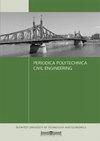基于应变设计方法的永久路面力学经验设计
IF 1.4
4区 工程技术
Q3 ENGINEERING, CIVIL
引用次数: 0
摘要
本文利用奥德马克原理建立了基于应变的永久性路面设计的力学-经验模型。本文将能承受300 msa最小设计交通量的沥青路面划分为永久路面。路面被认为是一个三层体系,顶层是沥青混合料,其次是松散的颗粒材料,它们位于土壤路基上。通过限制沥青层底部抗疲劳的径向拉伸应变和路基顶部抗车辙的垂直压应变,确定了路面中组成沥青层的厚度。在本分析中,车辙和疲劳的许用应变采用了IRC:37-2018中推荐的力学-经验相关性。通过Odemark的方法,应用Boussinesq的理论,将路面剖面转化为一个均质系统。为了验证永久路面的厚度,利用IITPAVE软件对路面不同层界面处的应变进行了比较,结果表明,采用该方法的路面断面在车辙作用下是安全的,但在疲劳作用下有一定的失效。此外,将IRC:37-2018得到的常规路面厚度与本文方法进行了比较,结果表明收敛性较好。研究发现,层状路面中沥青层厚度对疲劳的影响比车辙更敏感。在此背景下,修正的疲劳和车辙应变值被推荐用于永久性路面的设计。本文章由计算机程序翻译,如有差异,请以英文原文为准。
Mechanistic-empirical Design of Perpetual Road Pavement Using Strain-based Design Approach
Present paper deals with the development of a Mechanistic-Empirical model of the strain-based design of perpetual road pavement using Odemark's principle. The bituminous pavement which can withstand minimum design traffic of 300 msa has been classified as perpetual pavement in this paper. The pavement has been considered as a three-layered system with a top layer of bituminous mix followed by unbound granular materials which rest on soil subgrade. The constituent bituminous layer thickness in the pavement has been determined by limiting the radial tensile strain at the bottom of the bituminous layer against fatigue and the vertical compressive strain at the top of the subgrade against rutting. The allowable strain against rutting and fatigue has been used in the present analysis from mechanistic-empirical correlations recommended in IRC:37-2018. The pavement section has been transformed into a homogeneous system by Odemark's method for application of Boussinesq's theory. To validate the thickness of the perpetual pavement, the strain at different layer interfaces in the pavement was compared using IITPAVE software, which shows the pavement section using present method is safe against rutting but marginally fails under fatigue. Moreover, conventional pavement thickness obtained using IRC:37-2018 were compared with the present method, which shows reasonably good convergence. It has been found that the bituminous layer thickness in a layered system of pavement seems to be more sensitive to fatigue than rutting. In this backdrop, modified fatigue and rutting strain values have been recommended for the design of perpetual road pavement.
求助全文
通过发布文献求助,成功后即可免费获取论文全文。
去求助
来源期刊

Periodica Polytechnica-Civil Engineering
工程技术-工程:土木
CiteScore
3.40
自引率
16.70%
发文量
89
审稿时长
12 months
期刊介绍:
Periodica Polytechnica Civil Engineering is a peer reviewed scientific journal published by the Faculty of Civil Engineering of the Budapest University of Technology and Economics. It was founded in 1957. Publication frequency: quarterly.
Periodica Polytechnica Civil Engineering publishes both research and application oriented papers, in the area of civil engineering.
The main scope of the journal is to publish original research articles in the wide field of civil engineering, including geodesy and surveying, construction materials and engineering geology, photogrammetry and geoinformatics, geotechnics, structural engineering, architectural engineering, structural mechanics, highway and railway engineering, hydraulic and water resources engineering, sanitary and environmental engineering, engineering optimisation and history of civil engineering. The journal is abstracted by several international databases, see the main page.
 求助内容:
求助内容: 应助结果提醒方式:
应助结果提醒方式:


